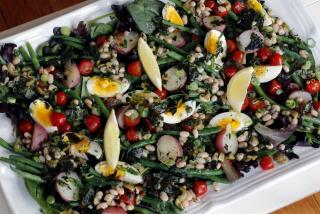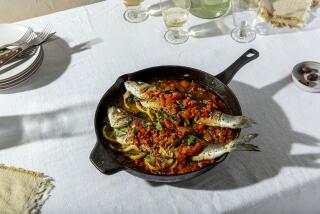New Diet Tips From the Stone Age
- Share via
Genetically, human beings haven’t changed very much for thousands of years. That is scentific fact. What has changed for many of us is the environment we live in and the amount of daily activity. For instance, most office duties are performed at a desk. Then we grab fast food on the way home, pick up a video at the corner rental outlet and “cocoon” on the living room sofa. The days of hunting and foraging for daily food are gone.
As a result, we are fatter and increasingly less healthy than our ancestors, whose diet consisted mostly of wild vegetation and game. Yet, even with the high amount of animal protein they consumed, they suffered from relatively few of the cardiovascular ills we experience today. Their calcium intake was double that of modern man.
The idea of increasing life expectancies by returning to a Stone Age diet was first presented in an article in the New England Journal of Medicine of Jan. 13, 1985. The recommendations have now been included in a new book that describes ancient eating habits and living patterns and suggests how these can be incorporated into contemporary life styles.
It’s Not a Diet Book
In spite of its title, there are no recipes in “The Paleolithic Prescription, a Program of Diet and Exercise and a Design for Living,” by S. Boyd Eaton, Marjorie Shostak and Melvin Konner (Harper & Row: $17.95, hardcover, 306 pages, not illustrated). What this book offers instead is an entertaining look at some scientific reports of prehistoric life. The data support the notion that the diet and exercise regimens of Stone Age man might be beneficial in the fight against disease. But it is not a diet book.
Eaton is associate clinical professor of radiology at Emory University School of Medicine in Atlanta, Ga. His colleagues are also from Emory: Shostak is adjunct assistant professor of anthropology; Konner is a medical doctor and anthropologist. The three analyzed dozens of primitive tribes from around the world and gathered fossil evidence to support their theory.
They hypothesize that while cave dwellers ate diets that contained substantial amounts of animal protein and cholesterol, our ancestors demonstrated a definite lack of cardiovascular complications, which the authors attribute to the exhaustive energy required for foraging for food. Furthermore, the consumption of wild vegetation, which tends to contain more calcium than do cultivated plants, contributed to the absence of osteoporosis in prehistoric man. And, they got 10 times the dietary fiber people do today.
These data support a plan for a life style based on genetic inheritance but stressing a return to a low-fat, low-sugar, high-calcium, high-fiber regimen--one that avoids the harmful ingredients common in a typical 20th-Century diet.
“Prehistoric life was not a bed of roses,” said Eaton. “Child mortality was 50% and few people lived to be 60. But most early humans died from falling off cliffs, infectious disease or battles, not poor health. Those who survived, by virtue of a balanced diet and a vigorous life style, appear to have escaped most of the chronic diseases of civilization such as heart disease, diabetes, osteoporosis, cancer and hypertension.”
Eaton also cited evidence that Cro-Magnon humans were taller and more muscular than modern Americans. They had better teeth and stronger bones, he said.
“Today, our bodies and lives are out of step with each other. We have genes that quite literally belong to the Stone Age. But we have drastically altered the way we live and our biology hasn’t had a chance to catch up. We’re living longer than our ancestors, but we’re dying from diseases they never knew.”
Some statistics given by the authors show that:
--The Paleolithic diet contained about half as much fat as does the typical American diet today.
--Our ancestors ate more polyunsaturated than saturated food.
--They had no dairy products after weaning, yet their calcium intake was twice that today.
--The sodium content of the Paleolithic diet was about one-fourth of today’s. They also consumed more potassium than sodium, which safeguarded their blood pressure.
--They ate 5 to 10 times the dietary fiber.
--Physical exertion was a constant feature of Paleolithic existence, with every aspect of life requiring considerable muscular effort.
--They had very little refined carbohydrate--far less sugar than we do and no finely ground flour.
--They probably had little or no alcohol and, in any case, could never have consistently obtained 7% to 10% of their calories from it, as average American adults today do.
These characteristics provide a generalized profile of the Paleolithic diet: low in saturated fat and salt; water as the major and usually only beverage; sugar, primarily as honey, available only seasonally; roughage or dietary fiber consumed in large quantities from wild, non-cultivated plant foods; meat prominent in the form of wild game, which is considerably less fatty than what we eat today, and probably very little alcohol consumption.
Some Scientific Support Lacking
One major criticism of the book is that it makes some recommendations for nutrient intake that are yet to be supported by the rest of the scientific community. These include increasing carbohydrate intake to 60% (from its current level of 55%) of daily total calories; protein jumps from the recommended daily amount of 15% to 20%; fat to constitute the remaining 20% (30% is the current intake level). Dietary cholesterol could be as much as 600 mg. per day, providing the fat intake does not exceed 20% and that polyunsaturated fat outweighs saturated in the diet. (The American Heart Assn. suggests that cholesterol not exceed 300 mg. per day.)
There is no recommended level for dietary fiber. However, nutrition experts believe 25% of the day’s total calories is a safe figure. Calcium intake is increased to 1,500 mg., provided there is no family history of kidney stones. Some vitamin supplementation is allowed.
The book also offers meal plans and gives preferred cooking techniques in a chapter titled “Hunting and Gathering in the Supermarket.” Roasting, baking and steaming are considered “relatively healthful,” with steaming being the most widely acceptable because it minimizes vitamin loss. None of the techniques listed require added fat. Deep-fat frying, grilling and barbecuing at high temperatures are avoided because of their carcinogenic effect.
As an example, breakfast emphasizes juices, fresh fruit, whole grains without added sugar and skim milk. Fruit is suggested as a natural sweetener. Unsweetened applesauce or fruit conserves are alternatives to butters and syrups.
For lunch, homemade sandwiches are the authors’ preference. Use whole-grain breads, tuna and turkey. Or, substitute with a container of salad or low-fat cottage cheese or yogurt with fruit. Sliced raw vegetables add extra fiber and vitamins. For dessert, choose fresh fruit and drink unsweetened ice tea or coffee.
Whole grains are again emphasized at dinner, including pasta and hearty non-cream-based soups such as minestrone or lentil. Chilled fruit soups are OK for variety. Entrees must be based on poultry, legumes, fish or shellfish, with game and comparably lean meat to be added only as substitutes, not the regular choice.
Snacks too are part of this eating program, but they are limited to raw vegetables, low-fat yogurt, fruit juices and applesauce, fiber crackers, low-fat cookies and skim milk.
“Much of what is prescribed--plenty of yogurt, vegetables, fruits, lean meats and poultry--may sound like your typical diet food,” said Eaton, “But there are significant differences. Diet books are too concerned with reducing calories, cholesterol and the amount of food consumed. Modern weight-loss experts tell us to eat less. I think we should eat more, but eat properly and exercise more.”
He concluded, “The biggest favor we can do for ourselves is to forget all of those trendy diets and return to the eating habits of our Stone Age ancestors. . . . For example, the number of calories you take in is not as important as where those calories come from.”






